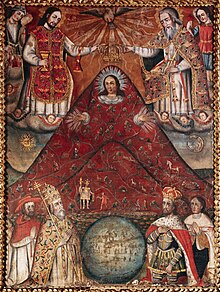This article includes a list of general references, but it lacks sufficient corresponding inline citations. (July 2017) |

Indochristian art (Spanish: arte indocristiano), is a type of Latin American art that combines European colonial influences with Indigenous artistic styles and traditions.
During the Spanish colonization of the Americas, Franciscan, Dominican, and Augustinian monks extensively converted indigenous peoples to Christianity, introducing them to European arts and aesthetics. The arts of this period reflect a fusion of European and indigenous religious beliefs, aesthetics, and artistic traditions.
The term Indochristian art was coined by Constantino Reyes-Valerio, a scholar of pre-Columbian Mesoamerican culture and arts, in his book, Indochristian Art, Sculpture and Painting of 16th Century Mexico. Reyes-Valerio's work focused on the painting and sculpture of churches and monasteries in New Spain, but had broader implications for the analysis of art throughout Latin America.[3]
- ^ "La Virgen Del Cerro" (in Spanish). Casa Nacional de Moneda. Retrieved 23 October 2019.
- ^ Leibsohn, Dana; Mundy, Barbara (2005). "Vistas: Visual Culture in Spanish America, 1520-1820". Retrieved 23 October 2019.
- ^ Reyes-Valerio, Constantino (2000). "Arte Indocristiano: Pintura y Escultura en la Nueva España". www.azulmaya.com. Retrieved 2017-04-07.
© MMXXIII Rich X Search. We shall prevail. All rights reserved. Rich X Search
